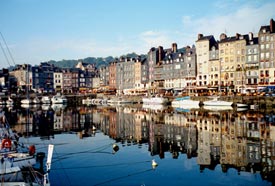|
Contax G2: The Ultimate 35mm Travel Camera?
Page 2
Continued from page 1
By Durant Imboden

ABOVE: The old French port of
Honfleur, Normandy, taken with the Contax G2.
The camera
Most of today's 35mm cameras (excepting disposables) are either:
Point-and-shoots. P&S cameras are typically designed for
beginning photographers. They offer a high degree of automation--hence the term
"point-and-shoot"--but are limited in flexibility.
Single-lens reflexes. SLRs are popular with professional
photographers and advanced amateurs because of their interchangeable lenses,
through-the-lens viewing, and the control they allow over shutter speed,
aperture, and automated programs. However, SLRs tend to be bulky, especially
when fitted with wide-angle or zoom lenses.
The Contax G2 is one of a small number of professional-quality
cameras that fall into a third category:
Rangefinder cameras. In a classic rangefinder camera such
as the Leica or Voigtlander Bessa, the photographer looks through a viewfinder
above the camera lens. Images from two separate points are combined (and
aligned) to determine the proper focusing distance by triangulation. This design
has several advantages over SLRs:
-
The camera can be smaller, since there's no need for a mirror
inside the body or a prism on top.
-
Lenses (especially wide-angle lenses) can be much smaller
and lighter than their SLR counterparts, since there's no mirror to require a
bulky "retrofocus" lens design.
-
In theory, at least, focusing can be more accurate at focal
lengths up to 90mm (the maximum lens length available on the G2).
The automatic rangefinder camera. The Contax G2 takes the
rangefinder principle one step further than its retro competitors by letting a
microprocessor perform the triangulation automatically. An infrared sensing beam
provides backup under dim focusing conditions.
Exposure metering is automatic, too, with centerweighted light
readings taken off the shutter curtain behind the lens. The photographer sets
the aperture (f-stop), and the camera determines the correct shutter speed. The
electronic shutter has a range of 16 to 1/6000 sec in automatic mode.
To give the photographer maximum control and flexibility, the G2
has features such as:
AF mode. You can set the camera for focus priority
(camera won't fire unless subject is in focus) or release priority (camera will
fire at any time the shutter is pressed).
AE lock. Flip a lever to set the exposure before framing
the scene. (Alternatively, you can set the camera up to lock exposure by
depressing the shutter halfway, using a separate focus-lock button to lock the
focus before shooting.)
Exposure compensation. This tells the camera to use a
longer or shorter exposure--e.g., when the subject is backlit. This can be
combined with auto bracketing, which lets you expose a scene at three
different exposure settings.
Manual focus. Point the camera at your subject and use
the manual-focus button to achieve focus. A display on top of the camera shows
the focusing distance in meters.
Next Page >
The lenses - Page 3
|